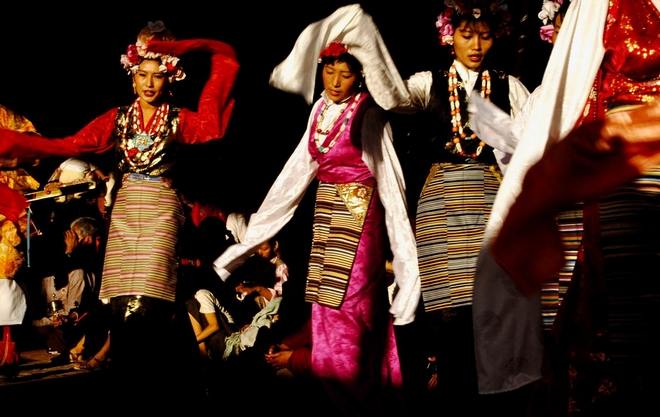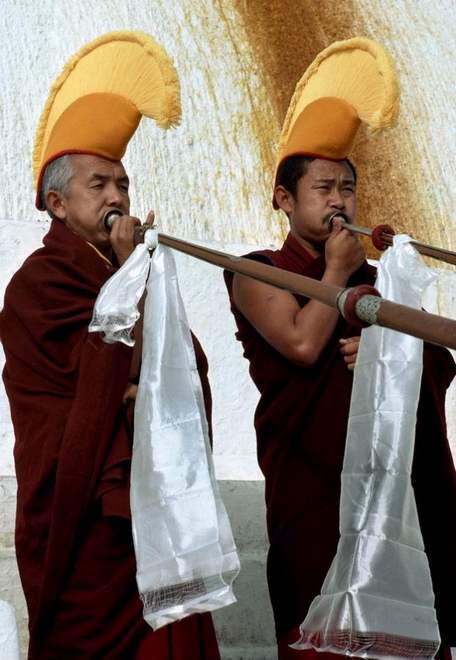
Tibetan women dance to celebrate the Tibetan New Year. Photo: Thomaslkellyphotos.com
The Tibetan New Year, similar to the Spring Festival of the Han people, is a traditional festival of Tibetans beginning from the New Year's Day in Tibetan calendar and lasting for 15 days.
Since Tibetans are Buddhists, the festival activities are at the same time religious, making the national festival a blend of entertainment, celebration and prayers.
Every year before the festival, each household will clean their houses and pour out the sewage westerly at the time of sunset, which signifies the disappearance of all diseases and evils along with the sunset.
The Tibetan people also paste their New Year paintings, paint the symbol of auspiciousness and eternity cross or the patterns of the sun and the moon, or portray the ears of naked barley on their gates with lime, white paint or Tsampa (roasted barley). Some households would paint their beams with white dots to indicate flourishing posterity and abundant food supplies.
The men in each village will ride to the "Holy Mountain" or "pure places" on the mountain to prepare the cypress branches for sacrificing to the gods in the New Year. The women will brew the naked barley wine at home and prepare food for the festival, such as deep fried bread, milk bread, blood sausage, meat sausage, fresh milk and mutton eaten with hands. Moreover, the Tibetans will prepare the Chema used for blessing prayer, which is a wooden cup filled with fried kernels, horsebeans, Tsampa noodle and ginseng fruit, with its top decorated with naked barley ears and small pieces of ghee. The Chema signifies the good harvest in the past year and wishes for favorable weather and abundant corns in the New Year.
In the first three days of the festival, the villagers will stay at home and dine together, play the "dragon lantern" and burn cypress incense to pray for stout livestock and lush plants in the year.

Monks blow long horns to celebrate the Tibetan New Year. Photo: Thomaslkellyphotos.com
A religious sorcerer's dance performance is also held in the region, in which the masked participants will dance to the rhythm of big cymbals, cymbals, gongs and drums. The local people wearing Tibetan costumes and adornments will also dance the Tibetan circle dance to the sound of regular two-stringed instruments, gong, drum and flute on the meadow.
Three days later, every household will bring their family members to pay a New Year call to each other. Guests entering a house will greet "bkra shis bde legs" (meaning good luck or God bless you), and the host will greet back the same words. Sometimes they will send blessing scarves named "hada" to each other.
|
|
||
 |
| Touched | Sympathetic | Bored | Angry | Amused | Sad | Happy | No comment |
Rhythm Media Group is a multi-media company, operating a US-based Chinese daily newspaper, The China Press, and the paper's website - uschinapress.com (which has mobile-app version), as well as a Beijing-based English website Sino-US.com. The group boasts 15 branch offices across the US, and a number of cultural centers focusing on culture-related business in the North America, Chinese mainland, Hong Kong and Taiwan.Launched in September 2012, the Sino-US.com is designed to serve as a bridge between China and the US, and to keep its readership inside or outside China better informed by providing news and insights on China's current affairs, culture, life, business, people and sports.
|
|